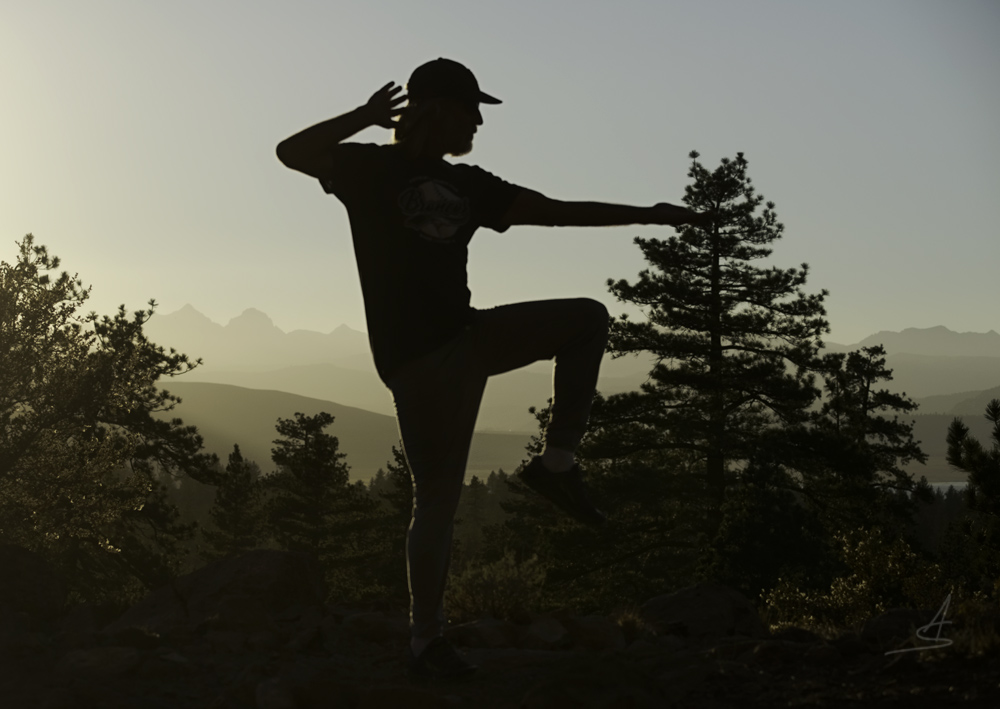A spreading virus, compounding breakdowns; it’s a wise part of life now to withdraw, fortify and assess. I find extra value now when I tend some vegetables, hike and climb, help my son practice baseball, and practice and teach T’ai-chi. And for a sense of just-in-case readiness I ask into an experience when things got really dire.
Three decades ago I went to climb a Himalayan peak with a woman named Kitty. She and I were only acquainted when I invited her, but I knew her charming Carolina accent hid a woman tough as nails, and she said yes right away. The peak was a giant tower at the Ganges headwaters named Thalay Sagar (“monument heading a valley”) and our goal was its unclimbed north face.

- Porters and our Liaison Officer arriving at Kedar Tal and our first view of Thalay Sagar
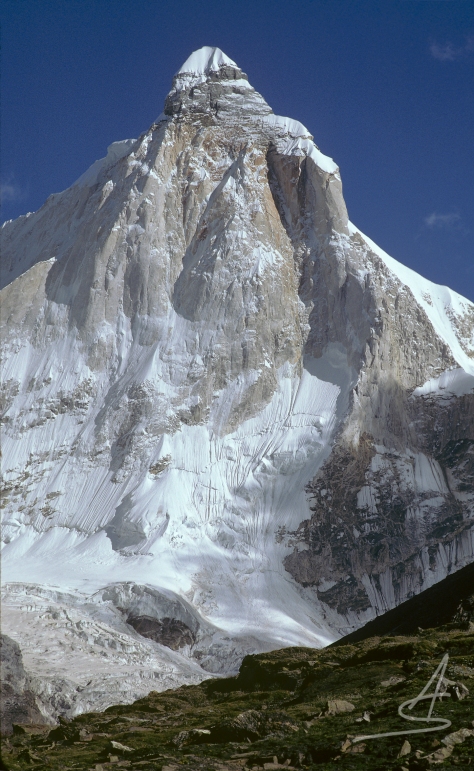
Thalay Sagar’s North Face
Thousands of feet of thin ice over steep rock called us into extended tip-toeing and riskier, deep poise than we’d ever found before. In four days we reached over half way up, high enough to look across ridges and feel ourselves in the rarefied realms. If you saw the film Meru Thalay is fairly like that, not quite as steep but icier and higher, in fact just a few miles west. At every move we calmed ourselves with the climber’s axiom; this is stressful, relax.

Kitty Calhoun starts the first pitch on Thalay Sagar’s north face
During our fifth morning a storm rolled in and started sending down waves of powder potent enough to knock us off. Out to the side of the chute we were in I found fortuitous cracks where I set a nest of four anchors I can remember to this day. From that hardware we hung our porta-ledge and crawled inside to wait. That evening we ate a half-dinner and agreed to save our remaining day and a half of food until the weather allowed us to go for the top.
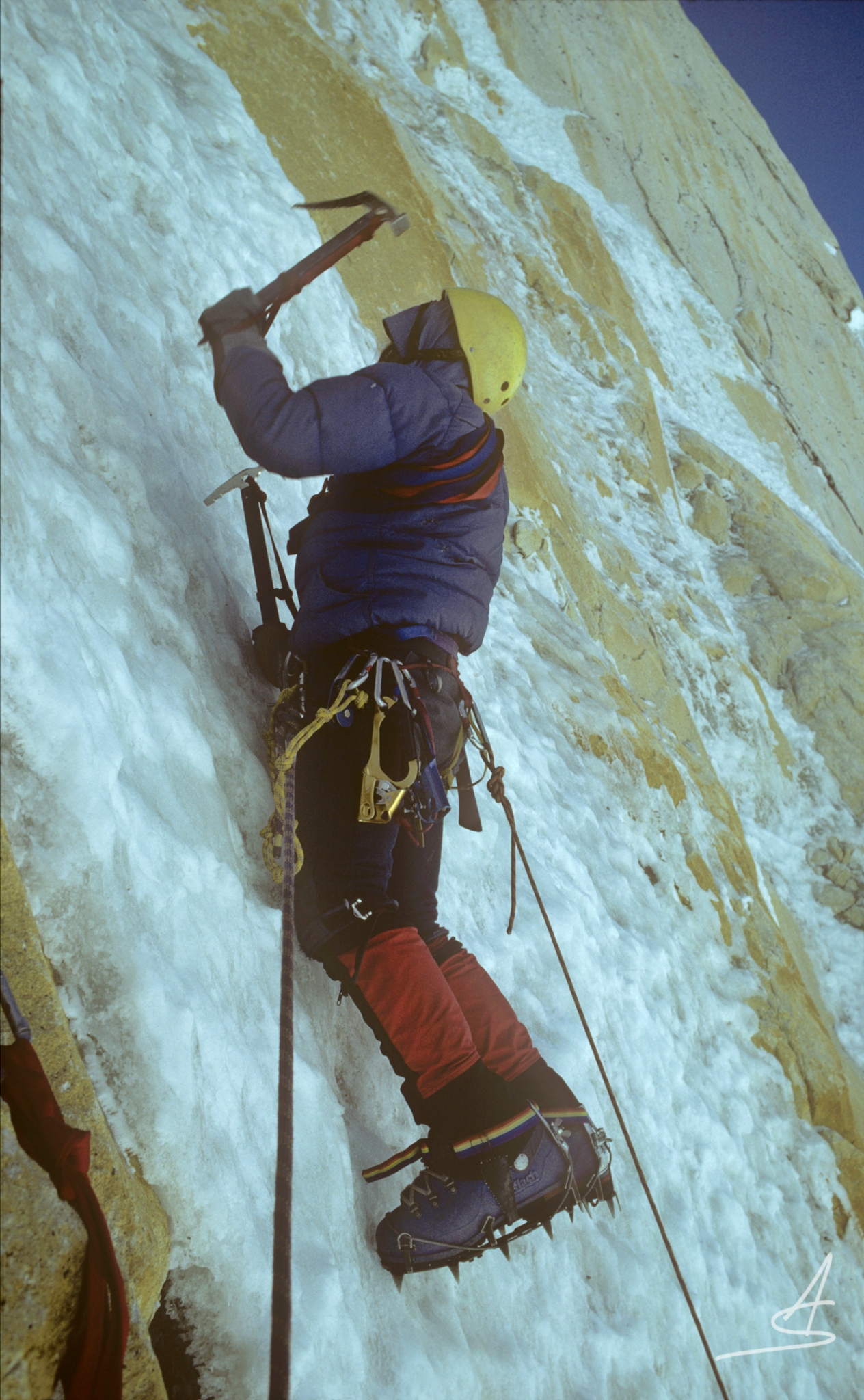
- Kitty Calhoun leads one of many thin-ice pitches on Thalay Sagar
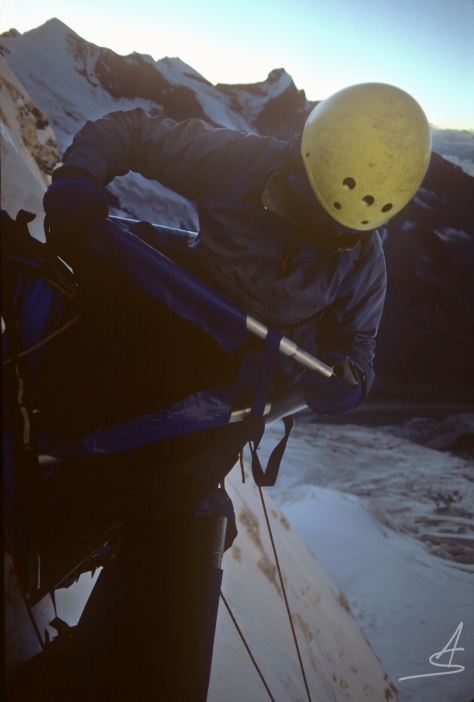
- Kitty assembling our porta-ledge for our second night on Thalay Sagar
Five days later we were still waiting there, getting really hungry as the storm kept on. It helped that the thin oxygen at over 21,000 feet makes lethargy the default, letting us sleep a good 16 hours a day. Each day we rationed ourselves a maintenance minimum, two mugs of warm water and a couple of spoonfuls of granola. For my larger size and higher metabolism, with Kitty’s encouragement I also took a daily spoonful of almond butter. Of course we kept tethered to those anchors. Daily highlights included reaching outside our blue-tinted micro-room to gather ice for water and to pee. These acts required coordinated counterbalancing to manage the ledge swinging. Each peek out from the capsule shocked us with the reminder that beyond the fabric waited nothing but ice-pasted buttresses disappearing into clouds. We transferred our ache to eat into discipline; yes we suffer, save reserves patiently.

- Kitty in the long wait for the storm to end
On the fifth afternoon of waiting I woke from a nap noticing it had become warmer and brighter. I bolted up in excitement for clearing skies, but my wakeup timing seems paranormal because I stuck my head out at the exact moment to see a huge avalanche sailing our way. I yelled to Kitty and as it hit us we braced our arms out against the force of it. Violence pounded us, turning it dark, thrashing, shaking and battering us harder and fiercer as if ravaging us down the maw of a vicious monster. Webbing and frame bounced and strained and I expected the anchors to snap and send us off to oblivion. Finally the horror slowed, and stopped. We shoved like crazy to rid the canopy of remaining snow, then sat screaming in silent terror.
I broke the roar to say, “We gotta get the fuck outta here,” and Kitty did not disagree. Warmer snow had stuck onto slabs above, and instead of pouring down like sand it had released in tonnage all at once. We went suddenly from patient soldiers to hunted prey.
Death’s glower sent me asking why I was there, and before long I saw clearly what I had only notioned before—that I could no longer care a whit for whatever rewards a climbing success might win, and motivations for recognition back home were a dangerous trap. However brightly the glow of admiration might light the way, terrain and weather do not recognize social currency. Our task was to engage the awe and risks of Thalay as impeccably as we could, and everything else we might live for depended on it. I understood that I climbed to find that purity of excursion, a motivation rooted in closets and dreams I was barely starting to open. At this point it was obvious we had to retreat, at dawn. Let go of habitual vision, see the challenges you really face.
But by dawn the storm re-intensified and in the two minutes it took me to descend just 50 feet multiple snow-waves swamped over us, driving icy powder into our layers. It was like doing skyscraper work in frigid surf and I realized we were profoundly screwed. With at least 25 rappels to get down some 3,700 feet we’d either freeze to death or make a fatal mistake. I jugged the rope back up to Kitty, and as waves crashed over us we had a hard time just re-hanging our shelter and diving back in. At that point reality hit harder than I could handle. We were trapped, and the determination we’d both learned to succeed by had to shake hands in the ring with despair. Thankfully cold had returned to keep the snow powder and pouring down the wall, at least for the time being. But we’d had almost no food for nearly a week and my body was dwindling. When I clenched my teeth I noticed them wiggling loose in their gums, and my mouth had an acetone taste that my biology degree recognized as a sign I was metabolizing muscles. Kitty offered that with a woman’s extra body fat she might be able to survive longer. Whatever, all we could do was lie watching snow hiss over the fly like sand through an hourglass. A path can really lead to having no options.
As we lived like corpses for two more days my will could abide no more. Every cell demanded action, anything, anyhow to escape. My mind started conjuring explanations, contriving fantasies, confronting shapeless demons and formless ghosts, rifling through its toolkit to no avail. We absolutely had to find the leverage to change the weather. Maybe we’d done something to offend the deities. How could things be so unfair? The recent monsoon had failed, bringing weeks of sun to thin the ice, and now in the supposed fair-weather season we faced the biggest storm ever? Weren’t starvation, renouncing fame, abandoning goals, and then a body pounding from death penance enough? I was ready to bargain, but with what? I never voiced my harangues to Kitty, I just kept flailing against sanity. Finally I landed at the person beside me. I insanely came to believe that the best hope to end the storm was to tell Kitty some important things. Respect your hope and ask with all your honesty if it points to true.
I told her how I had previously planned for Thalay with another friend, but he’d then betrayed what to me had been a romantic trust, making it impossible to have paired with him on an expedition. Kitty listened but offered little comment. But that evening the snow stopped, then some stars shone. Surely at last this was the storm’s end. I privately laughed to imagine how my opening up could have brought the clearing.
Alas, we woke to snowfall heavier than ever. There was no point to anything, the foolishness I’d imagined showed clear. I went back to thrashing for hope somewhere else because there was none worth the word.
When I woke again I came to admit there was more I should say. Early in the trip our excitement had included forays into our own romantic attraction, but now Kitty and I lie together sharing little besides small talk and valuable body heat. Fact was I’d privately pulled away because I’d seen roots of conflict. With Thalay looming so intimi-dating, I’d pictured a lover’s quarrel up on it as an existential nightmare. I was a searching soul, she was the most determined climber I’d ever met, and there we lie, unskilled in relating except when feeding each other rope to run with. I came to imagine that better weather and our lives depended on my gumption to clear the air between us.
I propped up and told her that I admired her and that I was glad she was my climbing partner in this tough situation, but that I was probably destined to pair with someone else. She listened but remained mysterious. We continued hanging in purgatory until I dug from my deeper history. I told her how I’d taken to mountains as a path apart from foul parenting and society gone toxic with pollution, wars and mindless jobs, how I sought to live instead by nature. Then she opened up too, telling how she also had taken to climbing out of rebellion, against expectations to be a Southern belle. Our talk unfolded further and felt cathartic, we became more like buddies. And that evening the snowfall stopped. Reach into your soul to reach out to your partners.
Dawn broke bright and clear! Salvation! But it came with brutal, sub-zero cold. We struggled just suiting up. I dropped our pot grips, and their tumble into gone reminded what falling would really mean. When we finally shouldered our packs my body had little energy even to shiver or move well, so Kitty led down. Each rappel was an ordeal, she searching to craft each new anchor, both of us struggling to slide down the ropes frozen stiff like cables, then gasping to team-heave them down. Each clip of a tether and each bite of an ice screw was life-crucial, and each wait for the other was temptation to give in to a blessed rest into forever. By early afternoon she said she was spent, but I’d revived enough to take over the lead. Come evening I re-faded but she’d revived, and I realized that without designing it our deepest reserves were coordinating.
As it grew dark she yelled up that she couldn’t find an anchor. I came down to join the search, then she slipped and broke our remaining headlamp. By feel I scanned the granite and found a slit to pound in a couple of small pitons to tether ourselves to for the night. We chopped a pitifully small ice seat, then broke out the stove to cook our long-saved final dinner packet, just as lightning flash-lit our gaunt faces looking to each other in shock, and it began to snow again. This was beyond appalling but we were too desperate to fret. Kitty pulled the fly over us while I operated the stove between my knees, and as we huddled like derelicts on a Himalayan sill I knew that if we didn’t get that food into us we would die. When we leaned against each other and dipped our spoons to bring the precious stew to our mouths the chewing and swallowing felt so unfamiliar and magnificent that the snow pouring over us merely registered. By midnight it cleared again and hope hung on.
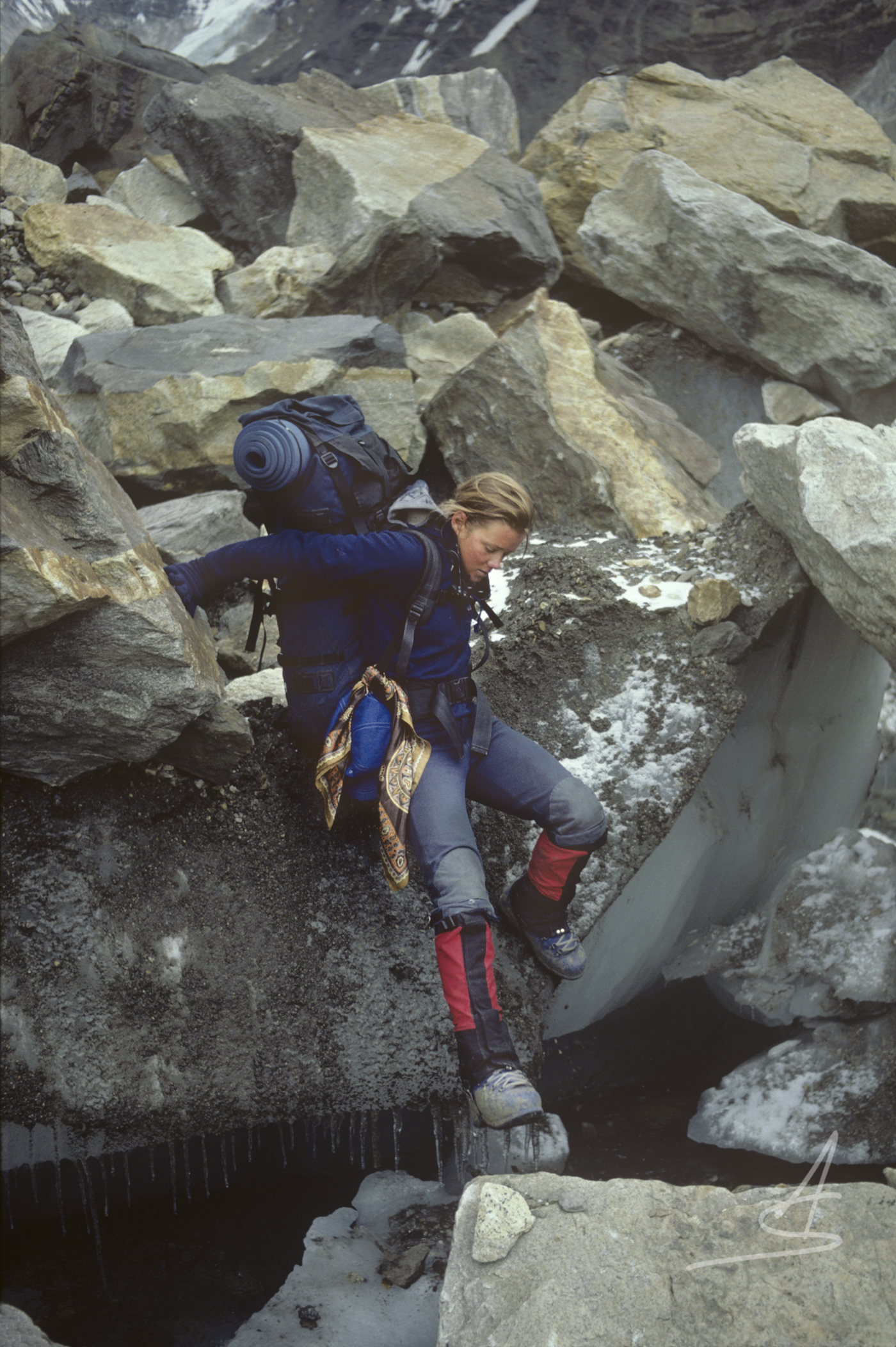
Kitty Calhoun packing gear across the rocky glacier below Thalay Sagar
The next day we finished our last rappel, we’d made it! We sat on our packs as if hallucinating; after two weeks on the wall the freedom to walk was a miraculous reunion. But next we had to wallow through new snow a dozen feet deep for a couple of miles. By dark we reached a boulder to spend the night under, then we dragged for another day to basecamp. There we collapsed, disoriented and stunned for how far we’d traveled since departing that grassy haven. It felt as if we’d been apart from humanity for a long time, and as we toured to the Taj Majal and to a guiding assignment in Nepal we took in all our encounters with child-like wonder. Kitty and I went our different ways and remained friends, climbing many more seasons and both rearing sons.
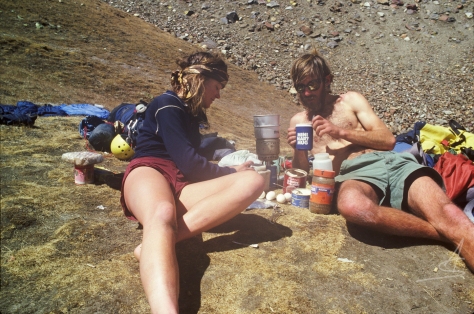
- Kitty and I cooking up our first food back in basecamp
I can’t recommend extreme climbing to anyone who doesn’t hear its outrageous call, but it is reassuring to know you’ve got extra reserves, and a journey to life’s edge informs all other experiences. No one risks their life without reasons that may be hidden, and this ordeal wrenched me into a lot of asking. With today’s breakdowns circling like vultures, we are called to venture out of our comfort zones; but into what?
It’s humbling to recall how when hope disappeared my sanity went chasing after it. I became like a ravenous don Quixote hailing and snarling at windmills, concocting self-serving delusions. I recognize this pattern in today’s news; at first we’re ready to endure, then as losses and confusion eat into us we retreat into despondence, act out in anger, and contrive wishful solutions.
What came like the cavalry to my rescue were three essentials. First was a hardening resolve at the inner belly/front of my spine. It was something like the force of life from the four directions collecting there to declare that I had willpower deeper than food nourishment and I’d better use it. It was a body-core determination to dismiss hunger and delusions and work through the location and situation we faced no matter what it took—and if we didn’t make it so be it.
That deep-belly tenacity wrestled me through nets of despair into the second essential, clarity. I recall wondrous moments of ultra-aliveness, moments when I could see all the things around us and their roles in our living on. I knew who I was and why I was there, and I could look at the details in our gear and the seams of the mountain and see it all fitting together. Just as the dropoff constantly reminded us to stay tethered to anchors, our utter isolation kept telling us to take our cues for action and patience not from fantasy but from our connection to Thalay and its weather. Living on is a matter of resonating with the things around us.
Third, I doubt we would have made it down alive without looking out for each other as well as for ourselves. When things got dire we opened up enough to fortify our little blue lifeboat with respect for our mutual vulnerability and will to live. We paddled our little dinghy of fabric and care for each other down the stormy abyss, operating beyond pride, entitlement and fear, partnering with each other’s strengths, foibles and mistakes like the nothings and everything they were. Dire challenge drew us beyond habits into what seems in retrospect like a state of instinctive grace.
We alpine climbers chase into absurd situations that force us out of our comfort zones into all kinds of letting go. Mountains teach us the hard way that it’s a dangerous mistake to project our ambitions and concepts onto them. It can take a lot of experiences to let mountains be mountains and take simple joy in tactile, technical and personal resonance with their edges and contours. That’s when we climb our best.
Today what I fear is our cultural inertia—that’s been so powerful for us—telling us we can forcefully design solutions independent from our surroundings and observable truth. We succeed only to a point, seeing through acculturated lenses and pulling social levers, but if we’re untethered and dissonant to the mountains and skies, oceans and cities, rivers and farms, and grizzlies and viruses we live with and live from, we risk all sorts of mayhem. Perhaps the corona virus can show us that despite our sophisticated civilization we are still both hunter and hunted, all mutually vulnerable and part of the whole. What civilization’s powers do for us is shift the predation on us to blowback from our own actions. We certainly suffer isolation these days, but what’s truly isolating is living as if our remarkable powers are untethered from the ferocious wonder around us.
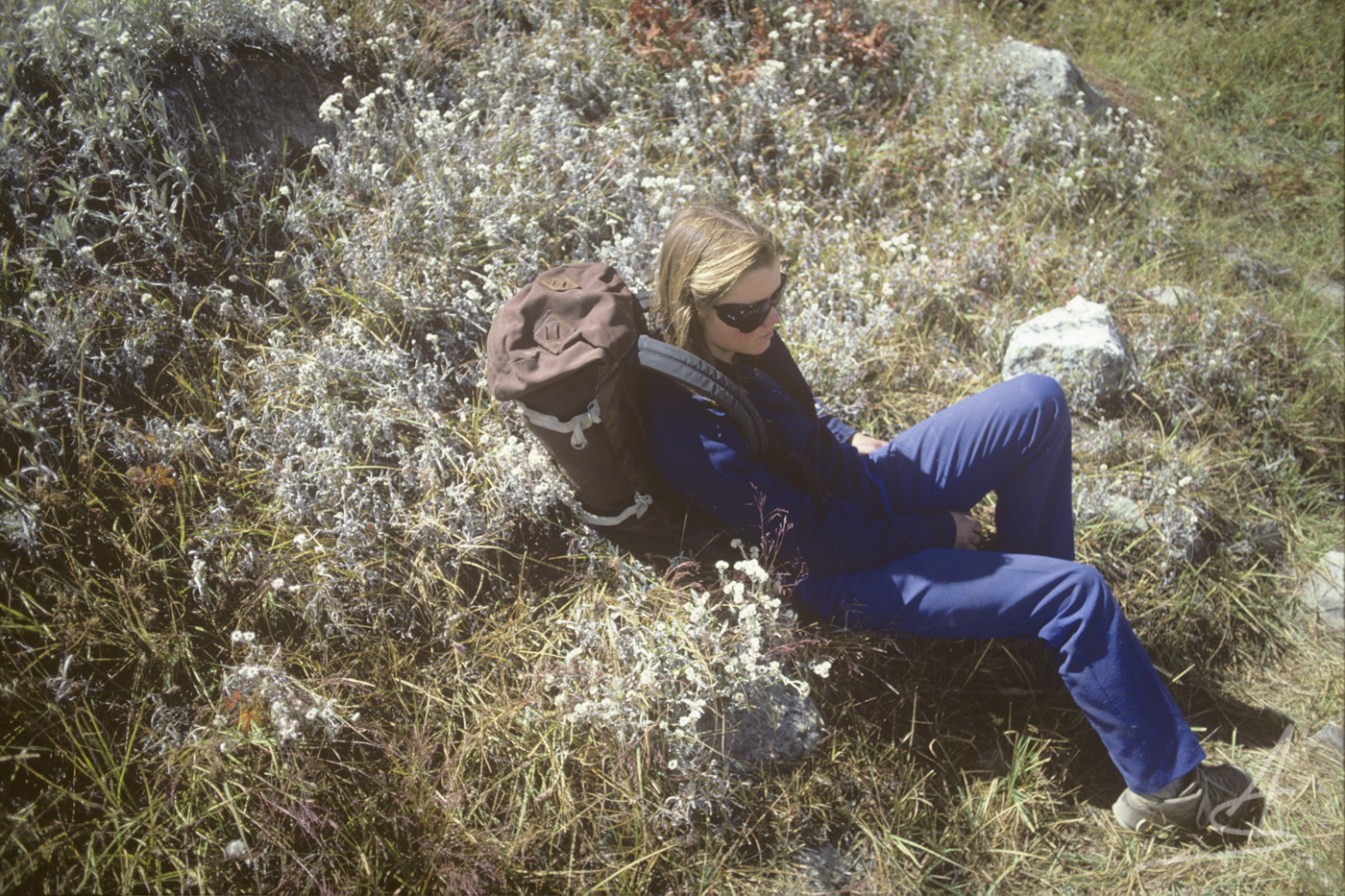
- Kitty resting on our hike out from basecamp
As things get tough and likely tougher I’m confident that any of us can find amazing tenacity, if we can find the clarity.

Kitty Calhoun on a bus in northern India
A clear image that speaks true is the “earthrise” photo taken by astronaut Bill Anders, looking back at home while orbiting the moon. That’s all of us in our blue-marbled lifeboat, rich with with many remarkable colors shared with all known living things, spinning through a fascinating and fathomless void.

- Earthrise from lunar orbit, 1968. Photo by Bill Anders courtesy NASA

